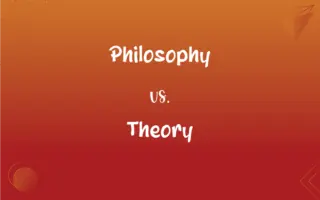Conservative Replication vs. Semiconservative Replication: What's the Difference?
By Janet White || Published on March 5, 2024
Conservative replication posits original DNA strands reassociate after replication, while semiconservative replication maintains one original strand in each daughter molecule.
Key Differences
In conservative replication, it's theorized that the parent DNA molecule remains intact after replication, with the newly synthesized strands coming together to form a separate daughter DNA molecule. This model suggests that after replication, one molecule is entirely original, and the other is completely new. On the other hand, semiconservative replication, the accepted model for DNA replication, proposes that each daughter DNA molecule consists of one original parent strand and one newly synthesized strand. This method ensures genetic continuity across generations, as half of the parental DNA is conserved in each daughter molecule.
The conservative model was initially proposed as a potential mechanism for DNA replication but was disproved by the Meselson-Stahl experiment in 1958, which provided strong evidence in favor of semiconservative replication. This landmark experiment used isotopic labeling to demonstrate that DNA molecules indeed split, with each strand serving as a template for a new complementary strand, resulting in two DNA molecules that each contained one original and one new strand.
Semiconservative replication is critical for maintaining genetic stability and fidelity, as it allows for the correction of errors during DNA synthesis. The presence of an original template strand in each new DNA molecule facilitates the repair mechanisms that correct replication errors, ensuring the accurate transmission of genetic information.
The conservative replication model, while not supported by empirical evidence for DNA, highlights the diversity of mechanisms that were considered before the understanding of genetic replication was solidified. It serves as a historical example of scientific inquiry and the process of validating biological theories through experimentation.
In practice, semiconservative replication underpins biological inheritance and cellular division, playing a foundational role in genetics, molecular biology, and the understanding of hereditary processes. The acceptance of semiconservative replication has shaped the scientific understanding of DNA function and replication, influencing research, medical advancements, and biotechnological applications.
ADVERTISEMENT
Comparison Chart
DNA Strand Composition
After replication, one molecule is all-original, the other all-new.
Each daughter molecule contains one original strand and one new strand.
Experimental Evidence
Lacks support from key experiments like the Meselson-Stahl experiment.
Supported by the Meselson-Stahl experiment, which used isotopic labeling.
Genetic Continuity
Theoretically maintains two separate DNA populations.
Ensures genetic continuity by conserving half of the parental DNA in each daughter molecule.
Error Correction
Hypothetical mechanism does not facilitate direct error correction.
Facilitates error correction through the presence of an original template strand.
Practical Relevance
Historical interest, lacks empirical support.
Fundamental to understanding genetic stability, inheritance, and molecular biology.
ADVERTISEMENT
Conservative Replication and Semiconservative Replication Definitions
Conservative Replication
Maintains distinct DNA populations.
In theory, conservative replication would keep original and new DNA molecules separate.
Semiconservative Replication
One original strand in each daughter molecule.
Semiconservative replication ensures genetic continuity by incorporating one parent strand into each new DNA molecule.
Conservative Replication
Lacks empirical support.
No experimental evidence has confirmed the conservative replication model in nature.
Semiconservative Replication
Facilitates error correction.
The presence of an original DNA strand in new molecules aids in correcting replication errors.
Conservative Replication
Entire original DNA reassociates post-replication.
If DNA replicated conservatively, each cell division would produce one completely new DNA molecule alongside the original.
Semiconservative Replication
Basis of biological inheritance.
Semiconservative replication underlies the process of genetic information passing from parent to offspring.
Conservative Replication
Theoretical interest.
Conservative replication serves as a conceptual model to explore alternative DNA replication mechanisms.
Semiconservative Replication
Fundamental to genetics.
Understanding semiconservative replication is essential for studying inheritance and DNA function.
Conservative Replication
Historical scientific inquiry.
Conservative replication illustrates the evolution of scientific understanding of DNA replication.
Semiconservative Replication
Supported by Meselson-Stahl experiment.
The experiment's isotopic labeling provided clear evidence for semiconservative replication.
FAQs
What distinguishes conservative from semiconservative replication?
Conservative replication theorizes entire original DNA remains intact post-replication, whereas semiconservative ensures one parent strand is in each new DNA molecule.
Why is semiconservative replication important for genetic fidelity?
It allows for error correction during DNA synthesis, maintaining genetic stability.
Has conservative replication been observed in any biological systems?
No, conservative replication lacks empirical support and is not observed in natural DNA replication processes.
How did the Meselson-Stahl experiment disprove conservative replication?
By demonstrating that DNA molecules contain one original and one new strand post-replication, contradicting the conservative model.
How do repair mechanisms interact with semiconservative replication?
Repair mechanisms utilize the original strand as a template to correct mismatches or errors, enhancing fidelity in semiconservative replication.
Why was the conservative model considered initially?
It was a theoretical proposition exploring how DNA might replicate before empirical data favored semiconservative replication.
Which replication model is supported by experimental evidence?
Semiconservative replication is supported by the Meselson-Stahl experiment.
What role does semiconservative replication play in evolution?
It ensures accurate genetic transmission across generations, facilitating evolutionary processes.
How does semiconservative replication contribute to genetic diversity?
By mixing one original and one new strand, it allows for a combination of genetic material, contributing to variation upon which natural selection can act.
What impact does the replication model have on biotechnology?
Understanding semiconservative replication is crucial for genetic engineering, cloning, and DNA analysis techniques.
In what ways has the understanding of semiconservative replication influenced genetic testing?
Knowledge of semiconservative replication has improved genetic testing accuracy, allowing for the identification of genetic disorders and ancestry information through the precise detection of DNA sequences.
What technological advancements have been made possible by understanding DNA replication?
Techniques like PCR (Polymerase Chain Reaction) rely on the principles of semiconservative replication to amplify specific DNA sequences for research, forensic, and medical diagnostics.
What role does the enzyme DNA polymerase play in semiconservative replication?
DNA polymerase synthesizes the new DNA strands by adding nucleotides complementary to each template strand, crucial for the semiconservative replication process.
What would be the implications if DNA replication were conservative instead?
A conservative replication mechanism would complicate error correction and might affect genetic diversity and evolution due to less efficient repair processes.
How do semiconservative and conservative replication theories reflect the scientific method?
These theories exemplify the scientific method through hypothesis formulation, experimentation (Meselson-Stahl), and theory validation or refutation, highlighting the iterative nature of scientific discovery.
Could the environment influence the mechanism of DNA replication?
While the basic mechanism of DNA replication is conserved across organisms, environmental factors can influence the rate and fidelity of replication, potentially inducing stress responses or mutations.
Can errors in semiconservative replication lead to mutations?
Yes, if errors are not corrected, they can result in mutations, impacting genetic information.
How does semiconservative replication influence medical research?
Insights into DNA replication mechanisms help in developing treatments for genetic diseases and understanding cancer cell proliferation.
What are the implications of semiconservative replication for aging and cell death?
Errors in replication and accumulated DNA damage over time can contribute to aging and cell death; semiconservative replication mechanisms include processes that attempt to minimize these errors.
How has the model of semiconservative replication impacted the field of evolutionary biology?
It provides a molecular basis for understanding how genetic information is conserved and varied within populations, offering insights into evolutionary processes and species diversification.
About Author
Written by
Janet WhiteJanet White has been an esteemed writer and blogger for Difference Wiki. Holding a Master's degree in Science and Medical Journalism from the prestigious Boston University, she has consistently demonstrated her expertise and passion for her field. When she's not immersed in her work, Janet relishes her time exercising, delving into a good book, and cherishing moments with friends and family.
































































